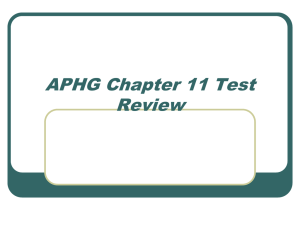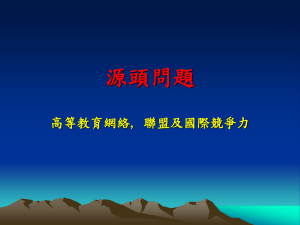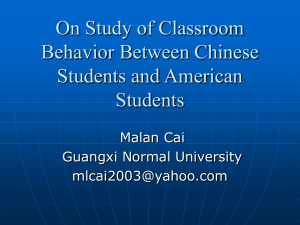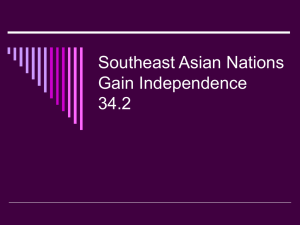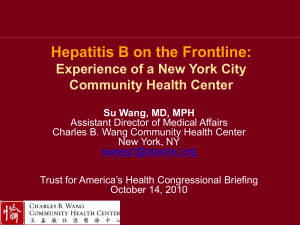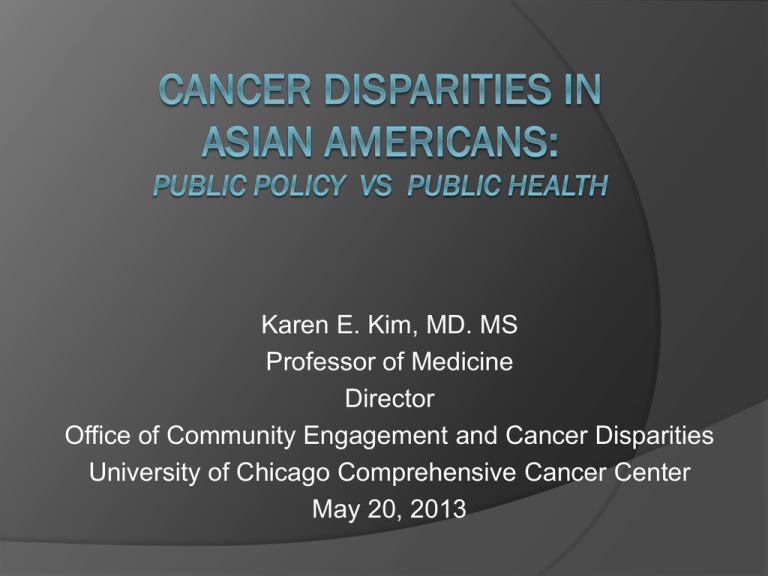
Karen E. Kim, MD. MS
Professor of Medicine
Director
Office of Community Engagement and Cancer Disparities
University of Chicago Comprehensive Cancer Center
May 20, 2013
Conflict of Interest
NCI P20-South Side Cancer Disparities
Initiative
AHRQ R24: Partnership for Healthier Asians
NCI: Community Health Educator supplement
CDC U54: Hepatitis B Education and
Prevention
President: Asian Health Coalition
VP: National Council of Asian American Pacific
Island Physicians
Steering committee-National Viral Hepatitis
Roundtable
Executive board: American Cancer Society
Objectives
Asian American Demographics and
Immigration History
Cancer among Asian Americans
Colorectal cancer: Public health and
public policy partnership
Who Lives In the Global Village?
If Only 100 people Lived In the World, There Would Be……
61 Asians
13 Africans
12 Europeans
9 Latin Americans
5 North Americans
4
Asian American Immigration History
1763-Filipinos in US-escapees from Spanish
ships
Early 1850’s California Gold rush
1882-Chinese Exclusion Act
1922-Japanese made ineligible for citizenship
1942-46-Executive Order 9066-Japanese
internment (> 2/3 were US citizens)
1965-Hart Cellar Act-abolished national origin
quotas (Japan 185, China 105, other Asian 100)
1990-Immigration Act
Life magazine of December 1941
CHINESE
Parchment yellow
More epicanthic folds
Higher bridge
Never rosy cheeks
Lighter facial bones
Longer face
JAPANESE
Earthy yellow
Less epicanthic folds
Flatter nose
Sometimes rosy cheeks
Heavy beard
Shorter face
Life magazine of December 1941
Asian American Immigration History
1763-Filipinos in US-escapees from Spanish
ships
Early 1850’s California Gold rush
1882-Chinese Exclusion Act
1922-Japanese made ineligible for citizenship
1942-46-Executive Order 9066-Japanese
internment (> 2/3 were US citizens)
1965-Hart Cellar Act-abolished national origin
quotas (Japan 185, China 105, other Asian 100)
1990-Immigration Act
Health Care Goals
Healthy People 201550% reduction in
cancer mortality; 25% reduction in cancer
incidence
DHHSEliminate health disparities by year
2010
Problems for AAPI
Paucity of Data for AAPI subgroups
Marginal funding for AAPI
Health care system
Model minority status
Marginal funding for AAPI
MEDLINE database-1966-2000
10 million articles
1499 (0.01%) directly involve AAPI health
CRISP database-1986-2000
150,369 federal health related grants
342 (0.2%) for AAPI health
How do we translate ‘evidence based’ medicine into communities?
Journal of Asian American Health (JAAH)
Demographic Trends
In 2010, > 70% 0f Asian Americans are
foreign born*
>35% are linguistically isolated
* Highest precentage for any racial/ethnic
group
Health Care System and AAPI
AAPI stand out as being one of the least
well-served
Asian Americans are least likely to:
Feel that their providers understand them
Be involved in medical decision making
Have confidence in their providers
adapted from Hong and Hong, NCORE, 2006
14
Model Minority
African American-sick, poor, diabetes,
cancer, disenfranchised, obese,
violence, can’t understand
Asian American-healthy, bird flu, smart,
listens, skinny
Cancer 2013
1.66
million new cancer
diagnosed in 2013
580,350 cancer deaths
1600 deaths/day
1 in 4 deaths
226 billion –cost of cancer
ACS Cancer Facts and Figures 2013
Cancer and Asian Americans
1980’s-Asian Americans were the first population to die
from cancer as the #1 cause of death
In 2009
US-Born AAPI
males
Foreign-born
AAPI males
US-Born AAPI
females
Foreign born
AAPI females
Heart dz
Cancer
Cancer
Cancer
Cancer
Heart dz
Heart dz
Heart dz
Asian Americans and Cancer Risk Factors
LIVER CANCER
H pylori infection and diet
STOMACH CANCER
Epstein Barr (EB) virus
NASOPHARYNGEAL CANCER
Human papilloma virus (HPV)
CERVICAL CANCER
Lifestyle factors(Migration effect)
BREAST CANCER
COLORECTAL CANCER
Chronic Hepatitis B Infection
20
20
Estimated New Cancer Cases* in the US in 2013
Cancer Screening for Asian Americans
How do we participate in public health?
Nasopharyngeal cancer − no screening
Liver cancer − no screening coverage in US
Stomach cancer − no screening guidelines in US
Breast cancer – 64%
Cervical cancer – 75%
Colorectal cancer – 47%
22
22
LEP and cancer screening
Jacobs, et al, Am J Public Health 2005
Public Health vs Public Policy
Public Health Interventions to Policy
Downstream-individuals, communities
Midstream-organizations
Upstream-regulations, access,
economic incentives (policy)
50
45
40
66%
35
30
25
28%
20
15
6%
10
5
0
Total
Downstream
Midstream
Brownson et al. Prev Chronic Dis 2010
Upstream
Gastric Cancer
2nd most common Worldwide
10% all cancers, 12.1% cancer deaths
Koreans have the highest prevalence
worldwide
Ranks in the top 10 cancers among
Koreans, Vietnamese, Japanese
Early detection decreases mortality
In the US, less than 10-20% of all gastric cancers are found
in the early stages 15% survival
ACA and SCREENING POLICY
The Affordable Care Act requires health plans
and encourages state-based Medicaid programs
to cover those clinical preventive services
recommended by the U.S. Preventive Services
Task Force (USPSTF) graded ‘A’ or ‘B’.
•
Gastric cancer screening
• No current recommendations
• Will this become a covered service?
Barriers to Screening for Gastric Cancer:
Evidence of Benefit
No randomized controlled trials reported
showing a decrease in mortality
Failure to identify early gastric cancer in
the US is most likely due to:
Low incidence (in majority population)
Lack of risk stratification
Lack of aggressive screening
NCI: Gastric Cancer
Gastric Screening Guidelines
The future?
ASGE 2010
‘suggest screening EGD for new US
immigrants from high-risk regionsespecialy with a family history’
Public Health Interventions/Outcomes
Downstream-individuals, communities
Midstream-organizations
Upstream-regulations, access,
economic incentives (policy)
50
45
40
66%
35
30
25
28%
20
15
6%
10
5
0
Total
Downstream
Midstream
Prev Chronic Dis 2010
Upstream
Chronic Hepatitis B (CHB) & Asians
~400 million infected worldwide
75% are from Asia
>1.3 million infected in US
> 50% are AAPI
Prevalence is 0.3% for the
Prevalence is 5-15%
general population in US
among AAPI in US (up to
30% in some groups)
Liver cancer rates increasing in
Liver cancer is 3rd
US
leading cause of cancer
in Asians
World Health Organziation. Factsheet: Hepatitis B. http://www.who.int/mediacentre/factsheets/fs204/en/
Derose KP, Bahney BW, Lurie N, Escarce JJ. Review: immigrants and health care access, quality, and cost.
Medical care research and review. 2009 Aug;66(4):355-408. Epub 2009 Jan 29.
Estimated New Chronic HBV Infections
by Place of Acquisition, United States, 1990-2005
Immigrants from other countries
United States
CDC, 2006
Policies and hepatitis B
?????
SCREENING POLICY
The Affordable Care Act requires health plans
and encourages state-based Medicaid programs
to cover those clinical preventive services
recommended by the U.S. Preventive Services
Task Force (USPSTF) graded ‘A’ or ‘B’.
U.S Preventative Services Task Force Guide to
Clinical Preventive Services 2010-2011
Strongly recommends screening for hepatitis
B virus (HBV) infection in pregnant women
at their first prenatal visit.
‘A’ Recommendation
Estimated Births to HBsAg-Positive Mothers,
United States, 2003
Race/Ethnicity 2003 Births
CDC Point
Estimate
Pooled
Estimate*
%
N
%
N
2,321,904
0.11
2,554
.09
2,090
African
American
576,033
0.5
2,880
.53
3,053
API- US Born
37,384
1.4
523
API- Foreign
Born
182,862
8.9
16,275
5.74
12,642
Hispanic
912,329
.09
821
.2
1,825
American
Indian
43,052
.5
215
.29
125
White
TOTAL
4,073,564
* Prevalence studies in 18 states since 1990
23,269
19,735
U.S Preventative Services Task Force
Guide to Clinical Preventive Services 20102011
Recommends against routinely screening the
general asymptomatic population for chronic
hepatitis B virus infection.
‘D’ Recommendation
USPSTF 2004: Rationale
The prevalence of HBV infection is low; the
majority of infected individuals do not
develop chronic infection, cirrhosis, or
HBV-related liver disease. Potential harms
of screening include labeling, although
there is limited evidence to determine the
magnitude of this harm
Evidence-based
Policy: FUNDING
VIRUS Prevalence %
Deaths
(millions)
unaware 2006
Vaccine CDC
budget
2010
HBV
0.8-1.4
65%
3,000
YES
HCV
2.7-3.9
75%
12,000
NO
HBV/ 3.5-5.3
HCV
HIV
1.1
15,000
21%
14,016
NO
$ per pt
24
$4/pt
Million
1.2
$1000/
Billion pt
Liver Cancer Has the Fastest Growing Death Rate in
the United States
Trends in US Cancer Mortality Rates
All Other Cancers
(Average)
Corpus & Uterus, NOS
Testis
Lung & Bronchus (Female)
Esophagus
Thyroid
Liver
-2
-1.5
-1
-0.5
0
0.5
Annual Percent Change (1994–2003)
1
1.5
.Available at: http://seer.cancer.gov/csr/1975_2003/results_merged/topic_graph_trends.pdf.
2
DISSEMINATIONATION SCIENCE
DISCOVERY
DEVELOPMENT
DELIVERY
CRITICAL DISCONNECT
Five-year Relative Survival Rates of Major
Cancers in Various Countries
Cancer Facts & Figures 2012
43
Colorectal cancer prevention
Prevalence of Screening Behaviors and Health Care Access By Sex and Asian
American Ethnic Group, 2003 California Health Interview Survey
Males
Chinese Filipino Vietnamese Korean Japanese White
FOBT Screening
>1 year or never
81.1
92.3
85.6
93.1
89.6
79.6
Within past year
19.0
7.7
14.4
7.0
10.4
20.4
>1 year or never
85.4
86.8
79.4
92.1
78.2
79.8
Within past year
14.7
13.2
20.6
7.9
21.8
20.2
Females
NHIS 2010, CRS
SCREEN ACT
Supporting Colorectal Examination and
Education Now (SCREEN) Act
(S.608/H.R. 1320)
Waives all Medicare beneficiary cost-sharing
for CRS with polyps
Medicare will cover pre colon cancer
screening visits
Supports quality service initiatives
CRS is covered under ACA
Affordable Care Act
Ultimate public policy
15.7% uninsured
AAPI-over 30% did not see an MD
within past year-least among R/E
2 million AAPI projected to become
insured
Legal Permanent residents status
2.7 million AAPIs will have access to
preventative services-greatest cancer
prevention intervention
Opportunities for Asian American
Health
Affordable Care Act
From least insured covered services
Medical homes
Electronic Medical Record
Place of birth
Language preference
National database/registry
2013 CLAS
Opportunities for APAMSA to
Reduce Disparities
Public Awareness Campaign
Community, Physician, Public Health
Partnership with other National
Organizations (AMA, NMA, NCAPIP)
Support the Pipeline
Cultural competency
Asian health disparities
Pritzker School of Medicine: Student language capacity
PSOM
93% (n=82)
28% speak on Asian language
1 in 5 graduating medical students are
Asian American
Opportunities for APAMSA as a
leadership organization
POLICY, POLICY, POLICY
Let the science drive public policy
Policies reflect populations with
disproportionate disease burden
Create system change
58

